

Lipedema, a chronic condition marked by the disproportionate accumulation of fat in the legs and arms, has perplexed and challenged the medical community for decades. Originating from the pioneering observations of Drs. Allen and Hines in 1940, the journey of lipedema treatment has evolved dramatically, from rudimentary recommendations of diet and compression stockings to groundbreaking surgical interventions. Dr. Wright’s upcoming talk with the Fat Disorders Resource Society (FDRS) from April 19-21 promises to shed light on this transformative journey and highlights the innovative strides in treating this often misunderstood disease.


Lipedema, characterized by pain, swelling, and an increased susceptibility to bruising, has long posed significant challenges in diagnosis and management. Traditional management strategies, while providing relief, often fell short of addressing the progressive nature of lipedema, leading many to live with unresolved pain and mobility issues. The condition’s overlap with lymphedema further complicated treatment approaches, necessitating a nuanced understanding of the lymphatic system’s involvement.
The 1990s marked a pivotal era in lipedema treatment. The introduction of the tumescent liposuction technique by Dr. Jeff Klein, which minimized blood loss and reduced surgical risks, set the stage for a new therapeutic approach. Dr Gerhard Sattler spent time with Dr Klein, bringing the new techniques to Germany. Dr. Gerhard Sattler’s pioneering efforts, alongside his colleagues, Drs. Stefan Rapprich and Manuel Cornely demonstrated the potential of liposuction in providing significant relief for lipedema patients. Despite early successes, concerns regarding potential lymphatic damage loomed, sparking heated debates within the medical community. The first abstract publication of the surgical reduction of lipedema was in 2002 from the Paris Dermatology Conference.
Lymphologists who focus on diagnosing and treating lymphedema were concerned with surgery for lipedema-causing lymphedema. Surgery, Trauma, and Radiation therapy can cause lymphedema. Lipedema women have an increased risk of developing lymphedema. The lymphologists who were treating lymphedema patients caused by liposuction and related surgeries were up in arms about the potential for lipedema surgery to cause more lymphedema. The controversy surrounding liposuction for lipedema underscored the need for meticulous technique and a deeper understanding of lymphatic anatomy. Studies conducted in the late 1990s and early 2000s meticulously examined the effects of liposuction on the lymphatic system, eventually paving the way for techniques that preserved lymphatic integrity while effectively reducing lipedema symptoms.
The Fat Disorders Resource Society (FDRS) has been instrumental in advancing the cause of individuals suffering from lipedema and related conditions. By fostering education, research, and advocacy, FDRS plays a critical role in raising awareness, improving patient outcomes, and supporting the development of effective treatments. Dr. Wright’s collaboration with FDRS underscores a shared commitment to enhancing the quality of life for those affected by fat disorders through education and innovative care.
The evolution of lipedema treatment through liposuction, particularly lymph-sparing techniques, represents a significant leap forward. Early adopters of these methods demonstrated remarkable improvements in symptoms, reduced need for ongoing conservative treatments, and a marked enhancement in patients’ quality of life. These findings, bolstered by subsequent studies, underscore liposuction’s role as a viable, long-term solution for managing lipedema.
Dr. Wright’s upcoming talk with FDRS is more than a historical overview of lipedema treatment; it’s a testament to the relentless pursuit of better outcomes for lipedema patients. By highlighting the journey from conservative management to surgical innovation, Dr. Wright emphasizes the importance of continued research, patient education, and multidisciplinary collaboration in tackling lipedema.
Through this dialogue, Dr. Wright and FDRS aim to empower patients and healthcare professionals alike, offering hope and direction in the ongoing battle against lipedema. The discussion will not only explore the milestones in lipedema treatment but also illuminate the path forward, emphasizing the necessity of accessibility to effective treatments and the ongoing need for advocacy and support.
As we anticipate Dr. Wright’s insightful presentation, it is crucial to recognize that the journey of lipedema care is far from complete. The collaboration between healthcare professionals and organizations like FDRS highlights the dynamic nature of lipedema research and treatment, underscoring the need for continued vigilance, innovation, and compassion in addressing this condition.
Armed with knowledge and support, Lipedema patients can navigate their treatment options with greater confidence, advocating for care that not only alleviates symptoms but also enhances their overall well-being. The dialogue between Dr. Wright and FDRS serves as a beacon of hope, driving home the message that significant strides in lipedema care are possible and within reach with perseverance and collaboration.
The history of treating lipedema is a narrative of challenge, innovation, and hope. Dr. Wright’s forthcoming talk with FDRS promises to be a profound exploration of this journey, shedding light on the milestones that have shaped lipedema care and the promising horizon of treatments. As we look forward to this event, let us rally behind the ongoing efforts to improve the lives of those affected by lipedema, inspired by the knowledge that together, we can make a difference. Through education, research, and advocacy, we can continue to push the boundaries of what is possible in lipedema treatment, ensuring that every individual has access to the care and support they deserve.
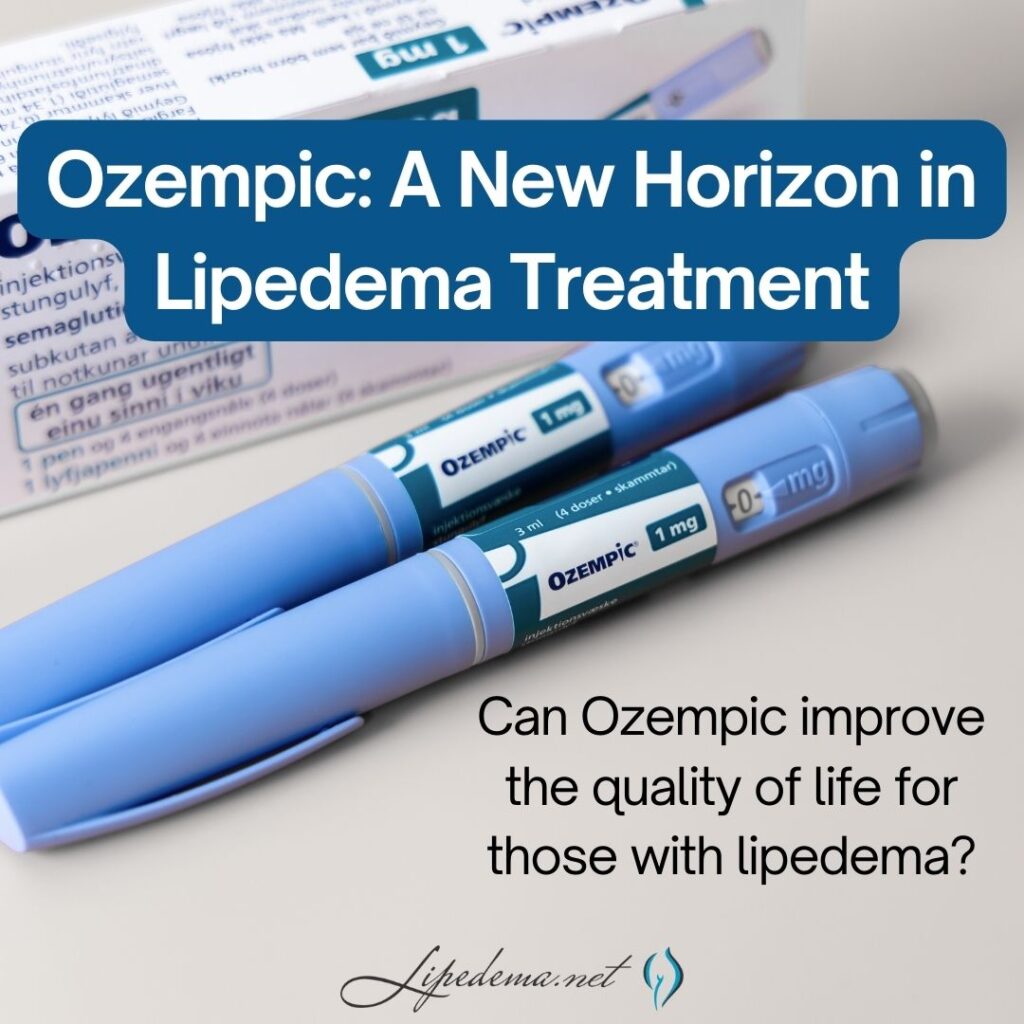

In the ongoing battle against lipedema, a condition that affects millions of women worldwide, patients and specialists alike are in constant search for effective treatments. Lipedema, characterized by the abnormal accumulation of fat cells in the legs, arms, and other body parts, can lead to pain, swelling, and mobility issues. Dr. Wright, a leading lipedema surgeon based in St. Louis, is at the forefront of exploring innovative treatments to help those suffering from this challenging condition. One such promising treatment is Ozempic, a medication primarily known for its benefits in weight management. While not specifically studied for lipedema, emerging evidence and patient reports suggest it might relieve some individuals struggling with this condition.
Ozempic, a brand name for the drug semaglutide, is an injectable medication originally approved for the treatment of type 2 diabetes. It works by mimicking a hormone that regulates blood sugar, satiety, and the slowing down of gastric emptying. In recent years, its weight loss benefits have gained significant attention, leading to its use in managing obesity and related conditions.
Lipedema is a complex condition; effective management often requires a multifaceted approach. The condition is not just about excess fat but also inflammation and pain. Here’s where Ozempic steps into the picture. While primarily used for weight loss, Ozempic also has properties that reduce adipose inflammation. These two effects – weight management and the reduction of inflammation – are crucial in lipedema.
Many individuals with lipedema struggle with weight control despite maintaining a healthy lifestyle. The stubborn fat associated with lipedema does not respond well to conventional weight loss methods, including diet and exercise. Ozempic’s ability to aid in weight loss presents a glimmer of hope for those who have found little success with traditional methods. By reducing the volume of lipedema fat, Ozempic could alleviate some of the pressure and discomfort in the affected limbs.
Lipedema is not just a cosmetic issue; it’s a painful condition often accompanied by significant inflammation. This inflammation can exacerbate the pain and swelling associated with lipedema. Ozempic’s anti-inflammatory properties might help reduce this condition, relieving many sufferers.
Dr. Wright, a renowned lipedema surgeon in St. Louis, has observed the potential benefits of Ozempic in managing lipedema. According to Dr. Wright, while Ozempic has not been studied explicitly for lipedema, there are encouraging reports from patients who have experienced improvements in their symptoms. These improvements include weight reduction in lipedema areas, decreased inflammation, reduced pain, and better mobility.
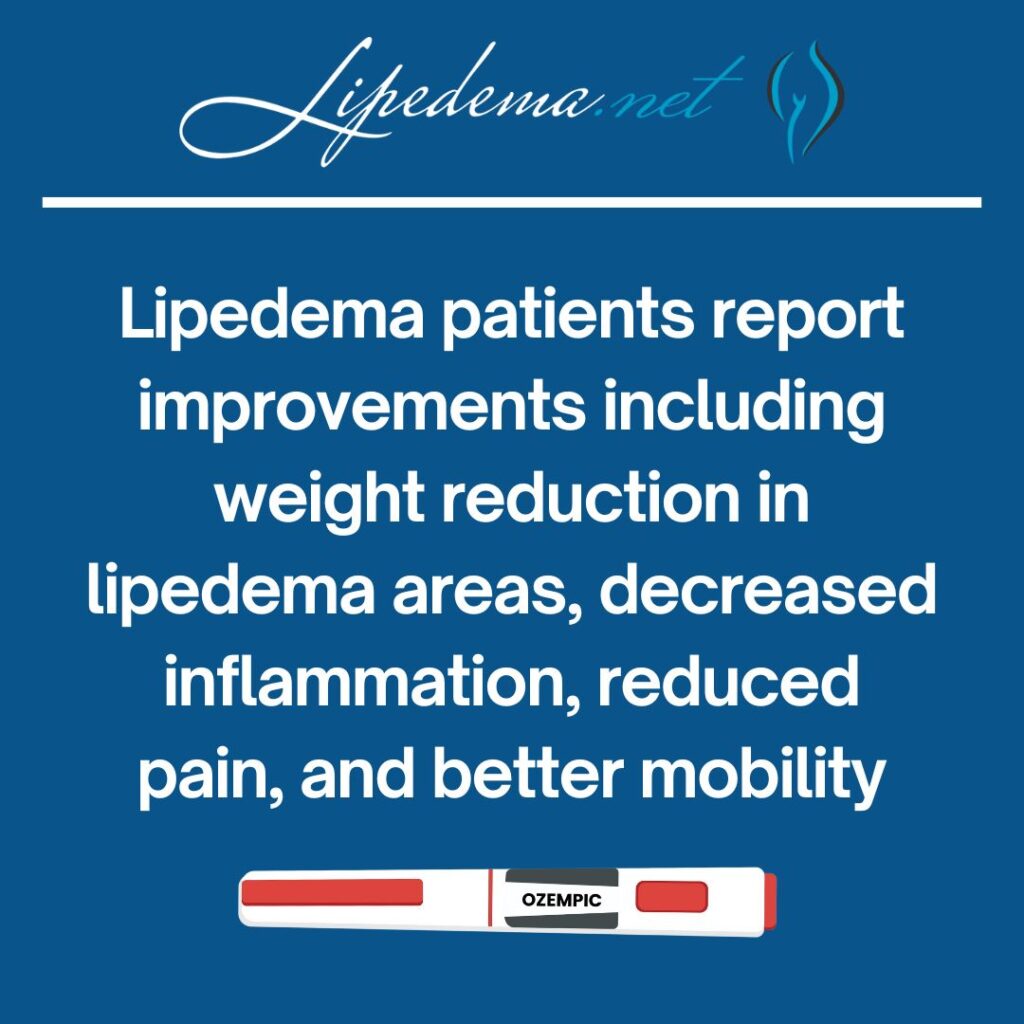

Most of the prescriptions for Ozempic in lipedema come from primary care physicians, not directly from lipedema specialists. Patients have reported a decrease in the size of lipedema fat deposits and improvements in related habits such as smoking, drinking, and nail-biting. This suggests that Ozempic’s benefits extend beyond the direct treatment of lipedema, potentially improving overall health and well-being.
As with any medication, Ozempic comes with potential side effects. Some patients may experience nausea, muscle loss, constipation, and other discomforts. It’s crucial for individuals considering Ozempic for lipedema to consult with a healthcare provider, preferably one familiar with lipedema, to weigh the benefits against the possible risks. Dr. Wright emphasizes the importance of a tailored approach, taking into account each patient’s specific circumstances and health profile.
The exploration of Ozempic as a treatment for lipedema is still in its early stages. More research and clinical studies are needed to understand its efficacy and safety fully. However, the anecdotal evidence and preliminary observations by specialists like Dr. Wright offer a hopeful outlook for many who have struggled to find relief from lipedema’s debilitating effects.
Dr. Wright advocates for a comprehensive approach to managing lipedema, incorporating lifestyle modifications, specialized treatments, and, when appropriate, medications like Ozempic. The goal is to address the physical symptoms of lipedema and the psychological and emotional challenges that often accompany the condition.
For women suffering from lipedema, the journey to finding effective treatment can be long and fraught with frustration. The potential of Ozempic to aid in weight management and reduce inflammation presents a promising avenue for research and treatment. Dr. Wright, a leading figure in St. Louis lipedema treatment, continues to monitor and evaluate the benefits of Ozempic and other emerging treatments for lipedema. While Ozempic may not be a cure-all, it could be a valuable component of a comprehensive treatment plan for some individuals with lipedema. As with any medical treatment, it’s essential to consult with a healthcare provider to determine the best course of action for your specific needs.
In the quest to improve the quality of life for those with lipedema, Ozempic represents a potential tool in the arsenal against this challenging condition. With ongoing research and patient feedback, we hope treatments like Ozempic will bring us one step closer to effective management and relief for those affected by lipedema.
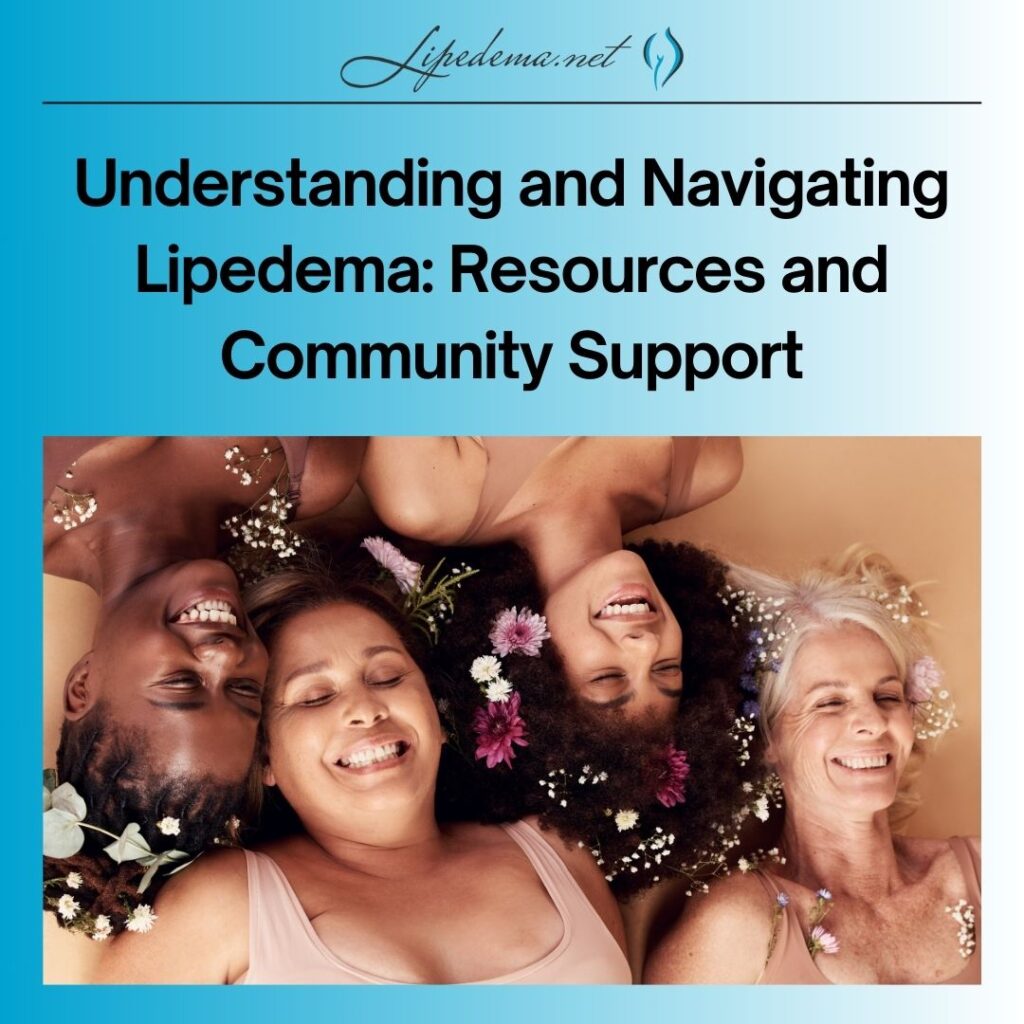

Lipedema is a chronic condition predominantly affecting women, characterized by abnormal fat accumulation in the legs and arms. It can be a confusing and often misdiagnosed condition, leading many to feel lost in their search for information and support. However, the internet has become a haven for resources, offering extensive information and a sense of community for those affected by lipedema. This blog will explore the wealth of resources available to women with lipedema, including the website lipedema.net, Dr. Wright’s YouTube channel, Facebook group, Instagram, and Pinterest pages, each offering unique insights and support for this condition.
Lipedema.net is an excellent starting point for anyone seeking comprehensive information about lipedema. This website is an extensive resource, providing detailed insights into the nature of the disease, symptoms, diagnosis, and treatment options. It offers:
For those who prefer video content, Dr. Wright’s YouTube channel, Lipedema Info, is a treasure trove of information. The channel features:
The Lipedema Group – Lipedema.net on Facebook is a vibrant community where members can find support and share experiences. This group offers:
Dr. Wright’s Instagram page, @lipedemasurgicalsolutions, is a visually engaging platform providing insights into the treatment and management of lipedema. Here, you can find:
Lastly, Dr. Wright’s Pinterest page, Laser Lipo Vein, is an excellent resource for educational material and inspiration. This platform offers:
Living with lipedema can be challenging, but with the right resources and support, managing the condition becomes significantly easier. From comprehensive information hubs like lipedema.net to engaging social media platforms like YouTube and Instagram, numerous avenues exist to explore for education, support, and community. Dr. Wright’s dedication to providing a wealth of resources across these platforms highlights the growing awareness and support for those battling lipedema. By leveraging these resources, women with lipedema can empower themselves with knowledge, find comfort in shared experiences, and remain updated on the latest in lipedema care and research.
Remember, while online resources are invaluable, they should complement, not replace, professional medical advice. Always consult with healthcare professionals for personalized medical guidance and treatment plans.
If you or someone you know is dealing with lipedema, we encourage you to explore these resources. Visit lipedema.net, subscribe to Dr. Wright’s YouTube channel, join the Facebook group, follow the Instagram page, and check out the Pinterest boards. Each platform offers unique perspectives and support, providing a comprehensive toolkit to understand and manage lipedema effectively. Join this growing community today and take a step forward in your journey toward wellness and empowerment.


Lipedema is a chronic and progressive disease that primarily affects women. It is often misdiagnosed as obesity or primary lymphedema, leading to a lack of understanding and appropriate treatment options. Lipedema’s physical and psychological consequences significantly impact the quality of life of those who suffer from it. This comprehensive guide will delve into women’s experiences with lipedema, highlighting their challenges and the importance of providing adequate care and support.
Lipedema is characterized by the abnormal deposition of subcutaneous adipose tissue, primarily in the lower body parts, such as the buttocks and legs. This adipose disease is of unknown etiology and tends to manifest during or after puberty, although it can also occur in connection with pregnancy or menopause. The accumulation of fat and fibrous tissue leads to bilateral swelling and enlargement, causing discomfort, bruising, severe pain, and limited mobility. Unfortunately, the progression of lipedema varies greatly, making it challenging to predict and control.
Conservative therapy, which focuses on patient education, weight control, manual lymphatic drainage therapy, and compression therapy, is commonly used to manage lipedema. Surgical interventions, such as liposuction, may be necessary in some cases. However, there are no easy solutions for treating lipedema, and further research is needed to develop more effective interventions.
Living with lipedema has a profound effect on the quality of life of women. The physical symptoms, including pain, fatigue, and limited mobility, significantly hinder their daily activities and overall well-being. Women with lipedema often describe their bodies as burdensome, feeling controlled and hindered by the swelling and pain they experience. The constant pain and discomfort can lead to exhaustion and a sense of helplessness.
Furthermore, the psychological impact of lipedema should not be overlooked. Women with lipedema often face fat-shaming and negative judgments from others, which affects their self-esteem and body image. They may feel unattractive and struggle with intimacy and sexual activity. The changes in their bodies, such as the appearance of loose and bumpy skin, pose additional challenges regarding hygiene and self-care. The lack of understanding and support from healthcare professionals further exacerbates their emotional distress.
Women with lipedema frequently seek medical help to address the changes in their bodies and the increasing pain they experience. However, obtaining an accurate diagnosis can be a lengthy and frustrating process. Many women have encountered healthcare professionals who lack knowledge about lipedema, leading to misdiagnosis or dismissive attitudes. Instead of receiving appropriate care, they are often advised to engage in weight loss exercises or visit physiotherapists and dietitians without addressing the underlying lipedema.
Women with lipedema often take matters into their own hands, researching and gathering information to understand their condition better. Some find the diagnosis themselves and present it to their doctors, only to face skepticism and hurtful comments. The lack of awareness and understanding among healthcare professionals contributes to feelings of isolation and a lack of support for women with lipedema.
Receiving a diagnosis of lipedema should be a turning point towards appropriate care and treatment. However, many women find themselves at a dead end. Despite having a confirmed diagnosis, they struggle to access the care they need. The limited knowledge about lipedema among healthcare professionals hinders the development of effective treatment strategies. Women with lipedema often have to fight for liposuction surgery, which can be crucial in managing the disease. They may also seek treatment abroad, incurring additional financial burdens.
The lack of guidance and support in medical decision-making further compounds the challenges faced by women with lipedema. They often feel alone, left to navigate their treatment options without sufficient professional advice. Some women have found supportive doctors who listen to their concerns and collaborate with them to develop appropriate treatment plans. However, these rare instances highlight the urgent need for increased awareness and knowledge among healthcare professionals.
Pain and fatigue are two significant symptoms that women with lipedema experience daily. The pain associated with lipedema is often described as aching, heavy, and unpredictable. It can worsen with movement and become stabbing in nature. Women with lipedema express feelings of exhaustion and describe the constant pain as debilitating. The invisible nature of their symptoms makes it challenging for others to understand and empathize with their experiences.
Fatigue, another common symptom of lipedema, further adds to the physical and emotional burden. Women with lipedema describe feeling constantly tired, which affects their ability to engage in daily activities. The lack of understanding and validation of their pain and fatigue by others, including healthcare professionals, leads to feelings of neglect and frustration.
Encounters with healthcare professionals play a crucial role in the lives of women with lipedema. Unfortunately, many women feel that their experiences are not taken seriously, resulting in a lack of dignity and respect. Healthcare professionals’ skepticism and dismissive attitudes toward their pain and symptoms contribute to feelings of violation and humiliation. Women with lipedema emphasize the need for healthcare professionals to listen, understand, and acknowledge their experiences.
Creating a supportive healthcare environment requires healthcare professionals to educate themselves about lipedema and its impact on patients’ lives. By validating women’s experiences and providing appropriate care, healthcare professionals can alleviate the emotional distress associated with lipedema. Collaborative decision-making and the involvement of specialists can also contribute to better treatment outcomes and improved quality of life.
Living with lipedema often leads to negative body image and decreased self-esteem. Women with lipedema may feel unattractive and struggle with self-acceptance. The changes in their bodies, such as the irregular distribution of fat and the appearance of cellulite, contribute to dissatisfaction and insecurity. The societal pressure to conform to narrow beauty standards exacerbates these negative feelings.
However, some women find solace in supportive relationships, particularly with their partners. Feeling desired and loved by their partners is essential for their overall well-being. The challenges of intimacy and sexual activity due to lipedema can strain relationships, but open communication and understanding can help foster intimacy and emotional connection.
Education and support play a vital role in empowering women with lipedema. Access to accurate information about the condition, treatment options, and self-care strategies can help women make informed decisions about their health. Support networks, both online and offline, provide a sense of community and understanding. Connecting with other women with similar experiences can offer emotional support and practical advice.
Additionally, psychological support is crucial for women with lipedema. Counseling or therapy can help address body image concerns, manage emotional distress, and enhance overall well-being. By addressing lipedema’s physical and emotional aspects, women can regain control over their lives and improve their quality of life.
The experiences of women with lipedema highlight the urgent need for change in healthcare systems and increased research on the condition. Healthcare professionals must be educated about lipedema to provide appropriate care and support. Developing evidence-based treatment guidelines and exploring novel interventions are essential to improve outcomes for women with lipedema.
In conclusion, lipedema has a significant impact on the quality of life of women who live with this chronic and progressive disease. Their physical and psychological burdens require healthcare professionals to approach lipedema with empathy, understanding, and respect. By providing adequate care and support, we can empower women with lipedema to navigate their journey towards better health and well-being.
Dr. Wright presented at the first World Congress on Lipedema, held in October 2023 in Potsdam, Germany. The common goal of this gathering was to share knowledge, experiences, and ideas related to the understanding and treatment of Lipedema and to benefit from first-hand, high-class education, network, and learn from world-renowned experts about the latest science and best practices in the management of lipedema.
The Lipedema World Congress is designed to bring together a broad spectrum of healthcare professionals, including lymphologists, plastic surgeons, angiologists, phlebologists, nutritionists, dermatologists, physical therapists, bariatric and Metabo specialists, and radiologists, as well as representatives of patient associates from around the world to share experiences and expertise on an international high-class level and to reflect on how to best incorporate these insights into education and clinical practice.
Dr. Wright gathered with peers from across the globe to learn the latest science and best practices in treating lipedema and shared his techniques and experiences treating patients. His presentation at the Lipedema World Congress was on how Lipedema Reduction Surgery Improves Mobility, Physical Function, and Multiple Measures of Quality of Life in Women with Lipedema.
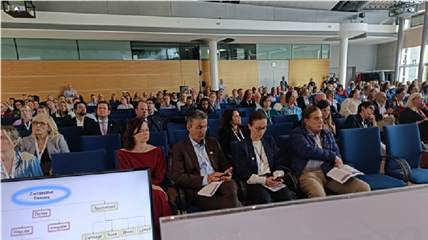

World Congress on Lipedema, Potsdam, Germany, 4-7 October, 2023.
This is the first time Lipedema has had its own designated Congress, in which leading experts from over 35 countries gathered to discuss and learn about the disease. More than 500 participants testified that interest in the subject is constantly growing and is bringing important news to the international scientific community. The US-based Lipedema Foundation had a large presence at the Congress, bringing along their staff to share knowledge with the large group of attendees. The Lipedema Foundation alone funds around 10% of the research projects on the disease.
Many colleagues from overseas also participated with great interest, and numerous representatives of patient associations from various countries joined the professionals. Attendees heard from Sharie Fetzer and Kate Forster of Lipedema UK, Valeria Giordano and Marcella Oggiano of LIO Lipedema Italia, representatives from American Fat Disorders, and leading experts representing Danish, Australian, Dutch, Swedish, Finnish, and Canadian foundations and practices.


World Congress on Lipedema, Potsdam, Germany, 4-7 October, 2023.
Sessions began with live commentaries of surgical procedures on patients; those present could talk, discuss, and ask questions to the surgeons who illustrated their techniques. Dr. Fabio Kamamoto of Brazil began by illustrating the technique of laser ligation with simultaneous endovenous laser ablation (also referred to as EVLA). This was followed by Dr. Mojtaba Ghods and his Potsdam, Germany-based team demonstrating the Lymph-sparing Hybrid Technique: MicroAire PAL Large-Volume Liposuction and Manual Extraction in General Anaesthesia for Advanced Stages Lipedema.
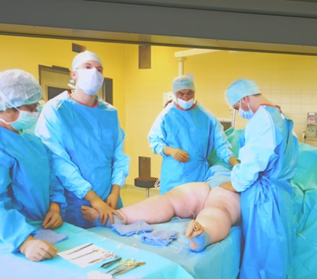

Dr. Fabio Kamamoto illustrates the technique of Laser Liposuction with simultaneous endovenous laser ablation.
Dr. Ziah Taufig of Cologne, Germany, demonstrated the Human Med body-jet technique WAL Liposuction in General Anesthesia, followed by Dr. Barbara Herstant of Paris, France, who described with a video presentation the technique of VASER Liposuction + Renuvion J Plasma in General Anesthesia.
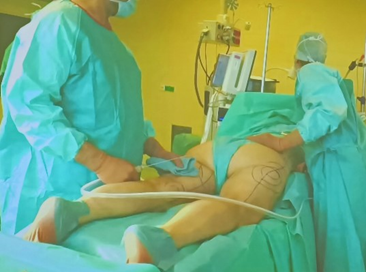

Dr. Ziah Taufig demonstrated the Human Med body-jet technique WAL Liposuction in General Anesthesia.
Finally, the first morning ended with a talk in the presence of our very own Dr. Thomas Wright, who illustrated his MicroAire PAL Liposuction in tumescent local anesthesia technique by video. The images alternating throughout the morning demonstrated how, with the application of effective techniques, the volumetric increase in the areas affected by Lipedema can be consistently reduced, with consequent benefits both functionally and on the symptoms related to the clinical picture.
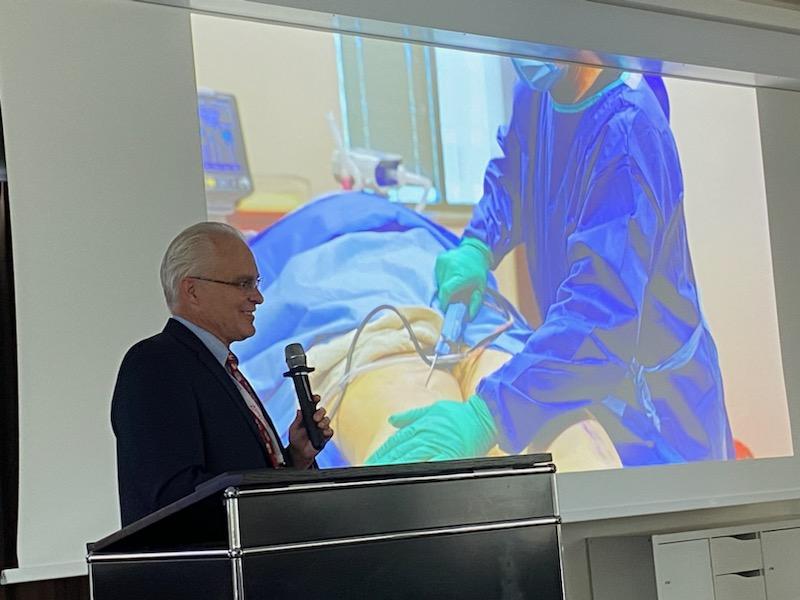

Dr. Thomas Wright illustrated his MicroAire PAL Liposuction in tumescent local anesthesia technique at the World Lipedema Congress.
The afternoon session began with a presentation by Christine Moffat on the current state of care for patients with lipedema, which highlighted the serious deficiencies that exist in most public and private care systems worldwide. Several presentations on home self-management of the condition followed this. At the end of the first session, the co-chairs of the Congress reminded the audience that the disease was only a little over a year ago, finally recognized by the World Health Organization with its own code (EF.02.2) in the eleventh edition of the International Classification of Diseases, welcomed all those present to a packed and attentive hall.


Dr. M. Ghods Co-Chair


Dr. K. Herbst Co-Chair


Dr. S. Michelini Co-Chair
The second session on the conservative treatment of lipedema followed this. Several authors (Ure Christian, Michelini, Serena, and others) presented their experience, emphasizing the essential symptomatic aspect (although long-lasting and important in terms of symptom regression) of the treatments themselves.
In the third session, papers were presented on the status of genetic studies (still much to be investigated, even though the disease has clearly been revealed as hereditary), on biochemical studies, and on anatomical studies that are bringing us closer to a better understanding of the pathogenesis of the disease. Several authors took turns, including the Australian Rami Shayar and the Italian Saverio Cinti.
The fourth session, with presentations by José Luis Simarro, was devoted to the pathogenic hypotheses of the disease and, in particular, some of its symptomatological aspects, first and foremost, pain.
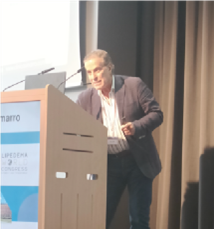

Dr. Simarro
The fifth and final session of the day was devoted to surgical treatment, particularly the various liposuction techniques, with the complementary aspects of using the various methods. Presentations were given by, among others, Thomas Wright and David Christel.
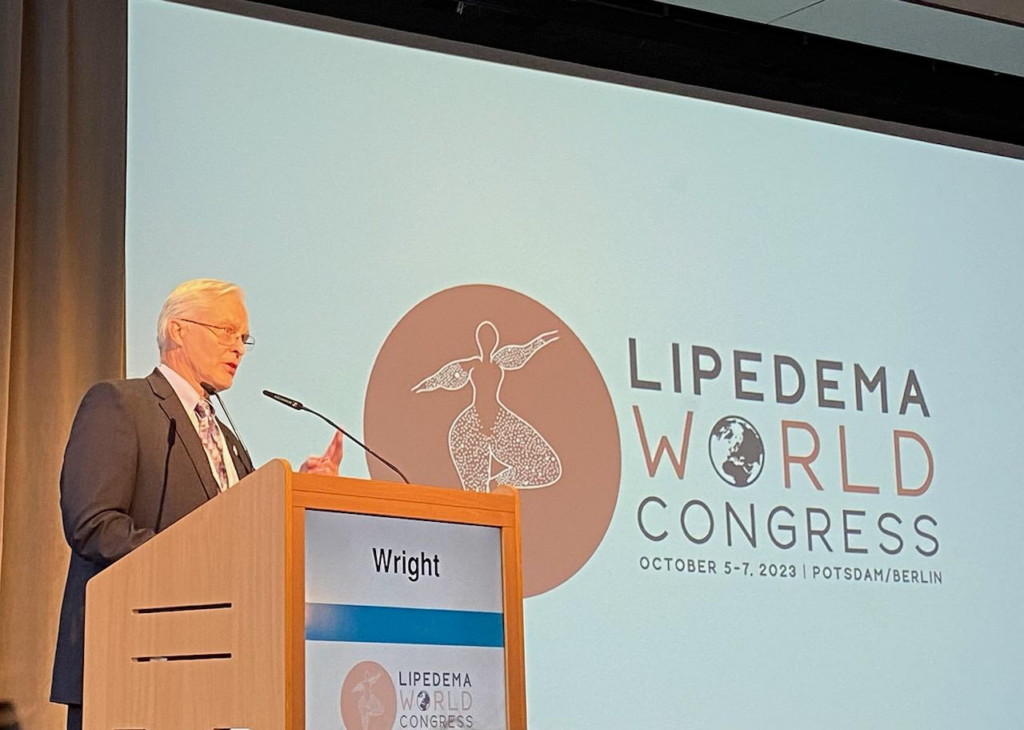

Dr. Wright
On 6 October, the day began with the General Assembly of the Lipedema World Alliance. The first of its kind, the LWA is a new and innovative association set up in 2022, made up of healthcare professionals, patient associations, and scientific societies. The Association is supported, in part, by ‘founding donors’, including Juzo Italia, Juzo International, LeSearch, Medi International, and Tactile Medical. The LWA’s president, Sandro Michelini, shared the motivations and steps that led to the creation of the association, emphasizing their mission, operating methods, and organizational charter. He also announced the start of registering regular members alongside their founding members. Potential members can review and submit their information to join the LWA here. During the assembly, several proposals were made, including that of organizing, if possible, a ‘dedicated’ international congress every two years in different locations.
The following session was devoted to the relationship between Lipedema and Obesity, which once again highlighted the fact that the association between the two pathologies is neither constant nor interdependent and that, in the case of obesity associated with Lipedema, bariatric surgery, which has a good effect on the classic sites of accumulation of adipose tissue, does not have such an effect in the anatomical sites affected by Lipedema itself.
The next session was followed by the presenter describing in more detail the aims of the Lipedema World Alliance. Johnatan Kartt described the activities of the Lipedema Foundation, which are mainly aimed at supporting scientific research. Dr. Karen Herbst and Dr. Gabriele Faerber then described the American and German Lipedema guidelines. Dr Faerber also compared the main consensus documents currently in place. During the lunch break, there was the opportunity to follow extra-congressional work with the description of other surgical experiences (WAL and other techniques) by several alternating specialists.
That afternoon, the resumption of proceedings was devoted to nutritional aspects; the presentations showed that the ketogenic diet (Giovanna Pitotti, Malgorzata Jeziorek, and other authors) and ‘low carb’ are the most effective dietary regimes in the disease. This was followed by the session on epidemiological and diagnostic aspects, with speakers touching on differential diagnosis aspects (Rachelle Crescenzi, Epameinondas Gousopoulos, and other speakers), including that between Lipedema, lipohypertrophy, and Secondary Lymphoedema. The last session highlighted the possible interactions between Lipedema and the lymphatic system. It featured other important and well-known speakers such as Stanley Rockson, Alberto Onorato, Jean-Paul Belgrado, and Hakan Brorson.


International experts possible interactions between Lipedema and the lymphatic system.
The evening ended with the Gala Dinner, during which the Lipedema Foundation honored Ghods for his scientific and care commitment. There were also some truly uplifting moments of fellowship and fun, during which it was possible to deepen mutual understanding between the various participants, as well as on some of the topics discussed after the presentations.
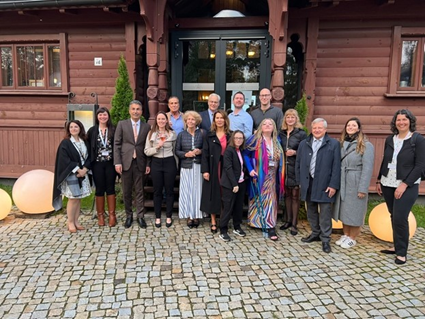

The Founder’s Dinner for the Founders of Lipedema World Alliance.
Saturday morning began with a plenary discussion on the results of the first two steps of the Delphi study, which was so well attended that it lasted for much of the coffee break time. The lively and substantive discussion led to the final draft [ of the contents of the paper that will be published in the coming weeks.
Dr. Kruppa prepared 100 statements about lipedema to review by the participants, and prior to the meeting, the statement had been modified and winnowed to 69 statements. The open session was chaired by Dr. Michelini, Dr. Kruppa, and Dr. Cresscenzi. During this time, Dr. Wright and nearly 100 experts worldwide discussed and debated the consensus statements.
The goal of this important project is to define what is agreed to be understood in the field of lipedema research and treatment. Also, to point out areas where more research and coordination are needed. The results of this work are hoped to produce a position paper focusing on lipedema coordinated by the Lipedema World Alliance. This document aims to comprehensively cover various aspects of lipedema, including its nature, epidemiology, pathophysiology, diagnosis, and treatment approaches. The intention is to create a resource that assists healthcare professionals, researchers, funders, and individuals impacted by lipedema in understanding the current opinions of experts and gaps in knowledge and management of the condition.
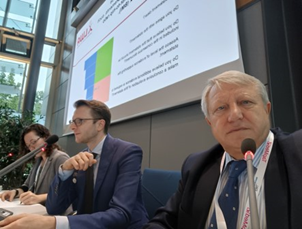

Left to Right: Dr. Crescenzi, Dr. Kruppa, and Dr. Michelini preside over the Delphi consensus discussions.
This position paper is the basis and starting point for further areas to be explored as they relate to lipedema. Given the evolving nature of lipedema research and the varying degrees of evidence available, reaching a unanimous consensus in certain areas might prove challenging. Acknowledging this, the project will employ a multi-step Delphi method to facilitate expert collaboration. This method will enable the group to iteratively evaluate and refine statements related to lipedema based on the current literature and collective expertise.
The last conference sessions followed this, the first of which was dedicated to basic science, histology, and molecular analysis. Among the various papers presented, the one by Cannataro, who, with the coordination of the writer, carried out on tissue samples selected and taken by the Plastic Surgeon Nicola Vaia in Rome, together with his wife Erika Cione (biochemist at the University of Cosenza), showed the data of a preliminary study that highlighted the presence of an ‘up-regulator’ micro-RNA as a possible ‘marker’ of the disease, arousing lively interest in those present (at the moment, the diagnosis of the disease is essentially clinical).


Dr. Cannataro explains data from a preliminary study that highlights the presence of an ‘up-regulator’ micro-RNA as a possible ‘marker’ of Lipedema.
The last session was again dedicated to various liposuction procedures. Various speakers took turns (including Agostino Bruno, Enriquez Burgos, Uwe Wollina, Corrado Cesare Campisi, Thomas Su, and others), highlighting some aspects relating to the effectiveness of the techniques and the sparing of other anatomical structures (first and foremost, the loco-regional lymphatic system).
As already mentioned, one of the novelties of the Congress was the role of the patients’ associations, which was much appreciated. This participation was precisely in the spirit advocated also by the WHO, of sharing the experiences of healthcare professionals with patients’ associations and, above all, finalizing the collaboration itself to the drafting of consensus documents useful in clinical practice and functional for recognition at the level of individual country governments.
The first World Congress on Lipedema upheld its promise to be an unparalleled gathering of experts and stakeholders in the field. Dr. Wright was honored to contribute his knowledge, learn from renowned experts, and collaborate with peers worldwide. Together, they’re paving the way for advancements in the understanding and management of lipedema.
Dr. Thomas Wright is a leading expert in venous and lymphatic medicine, with 15+ years of experience dedicated to advancing lipedema treatment. As the medical director of Laser, Lipo, and Vein Center, he’s among the first 200 US surgeons to attain diplomat status with the American Board of Venous and Lymphatic Medicine. He is a Fellow of the American Venous and Lymphatic Society. His research contributions include peer-reviewed papers on lipedema and co-authoring the US Lipedema Standard of Care Guidelines. Dr. Wright’s expertise covers lipedema reduction surgery, fat transfer, and minimally invasive skin tightening. Trained by Dr. Jeffrey Klein, he has performed thousands of tumescent liposuction procedures for cosmetic and lipedema patients, collaborating with institutions like Washington University and the University of Arizona to deepen our understanding of lipedema.
We are pleased to announce that Dr. Wright accepts patients for Lipedema Reduction Surgery in-network with United Healthcare. We are delighted that United Healthcare is working with us to provide the lipedema patient community with in-network lipedema treatment options. Please be aware that United Healthcare’s medical necessity criteria must be met to their satisfaction before approval. This includes six months of conservative therapy (diet, exercise, compression), photo documentation showing disproportionate tissue of the extremities, and documentation of functional impairment. We also highly recommend that patients document their personal journey to share with their provider and UHC to prove their need for further treatment.
We aim to help the lipedema community obtain affordable in-network treatment and care. We will continue to work with other payers to achieve fair compensation for the expertise and outstanding patient care and outcomes we provide to our patients.
Lipedema is a chronic condition affecting many women, causing disproportional fat distribution and significant physical discomfort. Fortunately, UnitedHealthcare (UHC) Insurance offers lipedema treatment insurance coverage, but it’s essential to understand their strict criteria and the steps required to get the coverage you need. We’re here to guide you through obtaining lipedema insurance coverage through UHC while shedding light on Dr. Wright’s success in securing coverage for his patients.


United Healthcare recognizes individuals’ challenges with lipedema and has developed a policy for treating this condition. However, it’s important to note that they have stringent criteria that must be met to qualify for lipedema covered by insurance. Below is the general outline of what criteria UHC is looking for. At the end of this article, we summarize the entire process that includes this criterion.
To be eligible for treatment for lipedema covered by insurance through UHC, you must meet the following criteria:
Diagnostic Criteria: You must meet all diagnostic criteria for lipedema. This includes having photographs showing disproportional fat distribution consistent with the diagnosis. Additionally, you must have documented evidence of the failure of disproportional fat to respond to medically supervised weight loss or bariatric surgery if your BMI is in class 2 or above (BMI +35).
Conservative Therapy: You should have completed medically supervised conservative therapy for lipedema for at least six months. This therapy includes compression garments, manual lymphatic drainage (MLD), and a low-carb diet. Documenting your efforts is crucial. You must document if symptoms persist despite diet adherence and compression use.
Medical Evaluation: In addition to diagnosing lipedema, you’ll need another diagnosis from your primary care physician (PCP) or a specialist who is not providing surgery for lipedema. This diagnosis should support the need for surgical intervention to treat lipedema.
Functional Impairment: To further substantiate your coverage case, you must provide documentation of functional impairment. This could include how lipedema affects mobility, physical activity, and daily life. Be sure to detail the limitations you experience due to lipedema, as this will strengthen your case.


One positive aspect to highlight is that Dr. Wright has had significant success in helping his patients secure lipedema insurance coverage treatment through United Healthcare. This speaks to the importance of having a knowledgeable and experienced medical professional on your side when navigating the insurance process. His patients have seen great success with lipedema surgeries and long-term quality-of-life changes. Below he and one of his patients were featured on FOX 2 St. Louis!
Now that you understand the criteria for UHC’s lipedema coverage policy, let’s outline the steps to help you secure the coverage you need:
United Healthcare does offer coverage for lipedema treatment, but they have strict criteria that must be met. By following the steps outlined in this article and enlisting the expertise of a knowledgeable specialist like Dr. Wright, you can increase your chances of obtaining the coverage you need to manage and treat your lipedema effectively. Remember that your health and well-being are worth the effort required to navigate the insurance process successfully.
Read more about the UHC Policy here.
We will make every effort to get patients approved for Lipedema Reduction Surgery; however, final approval for medical necessity and prior authorization is determined by United Healthcare and at the discretion of a Medical Director at United Healthcare. We cannot guarantee patients will be approved for surgical procedures.
The general rule of thumb for Lipedema Insurance Coverage claims reimbursements is that any given claim must be deemed “medically necessary”. Lymph Sparing Liposuction is nearly always considered a cosmetic surgical procedure in nature or experimental, meaning this is an elective procedure and not a medical necessity. Of course, as explained above, this is not the case for women with Lipedema, as lymph-sparing liposuction is the only treatment option for dealing with this disease that can reverse progression. However, the combination of the surgery being deemed cosmetic and election plus the general under-education and lack of awareness in the medical community has led to the battle patients and Lipedema surgeons are fighting. We must educate and advocate for these surgeries to be covered.
The liposuction CPT codes 15877-79 are cosmetic codes that were never intended to be used by commercial insurers to cover reconstructive or medically necessary procedures to improve function and technically should not be used for reconstructive treatment. Because they are cosmetic codes and are not covered by Medicare, they have never had a value or RVU (Relative Value Units) assigned to them. Some medical insurers like Blue Cross Blue Shield exploit the lack of an assigned value for the codes they insist on using. If an insurance company assigns little or no value to the surgery, even when it is a covered benefit, they can pay less for the 5-hour surgery than for a 15-minute follow-up office visit. This means that because they use cosmetic codes 15877-79, which can have little or no value assigned by commercial payers like Blue Cross Blue Shield, they can pay so little that they are, for practical purposes, technically “covering” treatment. But in practice, they’re not covering liposuction to treat lipedema. The good news, at least for now, is that UHC is covering Lipedema Surgery with a reasonable assigned value.
Despite the challenges and lack of coverage, some physicians, like Dr. Wright in St. Louis, do everything they can to work with patients to get insurance coverage. They are familiar with the ins and outs of different insurance providers, and their teams work extremely hard to get patient coverage. ERISA experts and attorneys can help you work on lipedema treatment coverage, and physicians can help you connect with them if you aren’t sure where to start.
You might also come across individuals who are self-described as “patient advocates”. These individuals will present themselves as experts in getting coverage for you. Still, they’re not licensed individuals and are unlikely to be bound by patient privacy laws that you’ll get with physicians and attorneys. We are aware of players in this field who are bad actors and ultimately hurt the cases of patient coverage. Be sure to check the BBB listings, names, and addresses of anyone wanting to work with you, along with Google Reviews and website listings.
Please reach out to our office, and Dr. Wright’s team would be happy to refer you to experts depending on where you are in your Lipedema diagnosis and treatment journey. We’re here to help, and happy to get you started!
Dr. Wright’s innovative lipedema surgery techniques are transforming lives by improving mobility and enhancing the quality of life for patients. He will be conducting a video demonstration of his surgical techniques in a Master Class for Lipedema treatment at this year’s 1st Annual Lipedema World Congress. 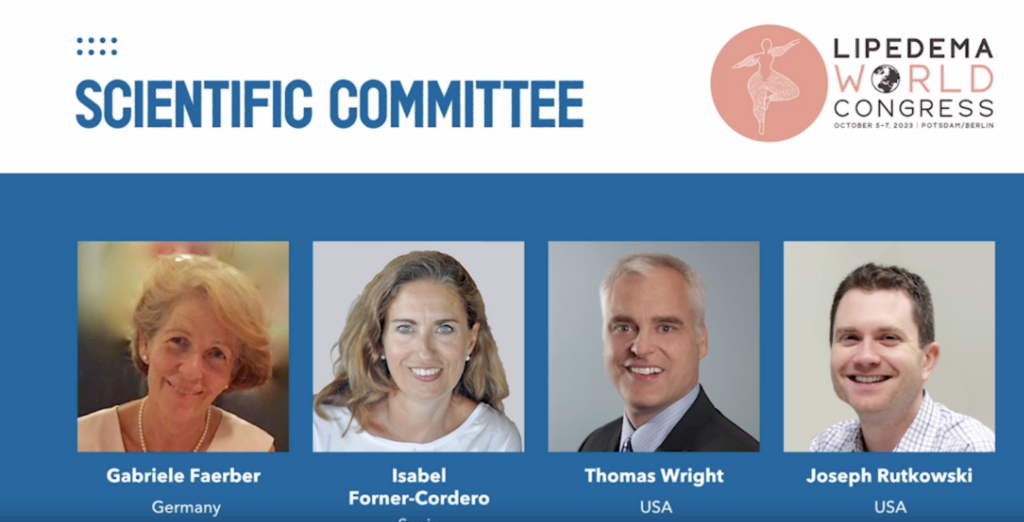

As a founding member of Lipedema World Alliance (LWA) and with expertise in this procedure, Dr. Wright will present the Tumescent Local Anesthesia (TLA) approach using power-assisted liposuction. In this course, he will describe his approach and techniques to give the best surgical outcomes and the greatest impact on mobility and quality of life long-term. His video demonstration and Master Class will be conducted on October 4, 2023, in Potsdam, Germany, with international participants from Spain, Italy, Austria, Germany, Norway, Lithuania, Sweden, Australia, India, Argentina, Brazil, USA, Iceland, Denmark, and Turkey. Below, we outline the topics and steps Dr. Wright will discuss.
Patients must first implement an anti-inflammatory diet and compression therapy. Their diets should emphasize low-refined carbs and avoiding processed foods, and medical-grade compression optimizes lymphatic function and tissue inflammation. These combined measures can decrease limb size, decrease pain, and lead to softening of the lipedema tissue ahead of surgery.
Before lipedema surgery, using high-frequency Ultrasound, the greater and smaller saphenous veins are mapped, and adjacent principal lymphatic collecting ducts are located. The watershed area around the principal superficial lymphatics in the legs is approached with extra care during surgery.
Tumescent fluid helps protect vascular and lymph vessels from injury, so the surgical area must be completely tumescent. Dr. Wright was trained in the Tumescent Technique by its inventor, Dr. Jeffery Klien. He follows The Klein Method and Dosing. General anesthesia adds the risk of general anesthetic medication. It can also lead to areas of inadequate tumescence because the general anesthesia blocks the ability to find areas that were incompletely tumescent.
Dr. Wright uses small (3mm) blunt cannulas to remove as much lipedema-affected adipose tissue as possible. This process works to debulk the area using longitudinal techniques.
The cannula is directed in longitudinal strokes, especially in the areas marked with lymphatic collectors, so it allows transecting of the lymphatic vessels. This requires frequent position changes, sometimes 8-12 different patient re-positions, to ensure he can remove the tissue using longitudinal cannula strokes.
After as much lipedema-affected tissue as possible has been removed with the suction cannula, he feels and massages the affected areas to check for any remaining fibrous lipedema nodules. If lipedema nodules are still present, then we manually loosen the nodules. If necessary, we manually extract them with an additional puncture of incision.
The patient is then placed in medical-grade compression to be worn for 24 hours a day for the first month.
Early-stage Lipedema (Stage 1) has small nodules the size of small seeds or peas, which often appear pearl-size. Middle-stage Lipedema (Stage 2) has larger nodules that feel the size of walnuts or gumballs. The presence of lobules characterizes the later stage, Lipedema (Stage 3). The nodules in Stage may be the same size as those in Stage 2, or they may be larger up to the size of a plum.
In the earlier stages of Lipedema (Stage 1 and most patients in Stage 2), the subcutaneous nodules are removed with lipedema reduction surgery, which involves modification of cosmetic liposuction using tools and techniques that minimize harm to the lymphatics. In lipedema patients with larger or more adherent nodules, the nodules have to be manually extracted.
In these cases, a small incision is made over the nodules that resist removal with a suction cannula and are gently milked out of the skin. Surgeons don’t want to cause any more trauma than is absolutely necessary. However, there are instances where this method is the only way to get larger, more adherent nodules removed. Dr. Wright has several videos of the extraction process you can view here.
The procedure typically takes several hours to complete, depending on the extent of the lipedema.
Patients may experience some discomfort and swelling in the days following the procedure, but this can be managed with pain medication and other treatments.
Most patients can return to work and other activities within a week or two, although this may vary depending on the extent of the liposuction and individual healing rates.
By reducing the amount of subcutaneous fat tissue, you can reduce any pain associated with lipedema. Lipedema reduction surgery, sometimes called Lymph sparing liposuction, will help you increase mobility without having the pain you have been feeling with lipedema since it started. This is huge for women with lipedema, especially because the pain and bruising is the leading symptom of seeking treatment. Women report a significant improvement in their ability to move around more freely, exercise more regularly, and enjoy day-to-day activities that were previously off-limits. Bumping into a chair or a corner no longer causes large bruises, playing with the family dog doesn’t cause pain when they jump, and everyday activities are no longer considered out of reach.
Lipedema, also known as lipoedema, is a chronic condition that affects many women worldwide. It is characterized by an abnormal accumulation of painful adipose tissue, primarily in the legs. Unfortunately, lipedema is often misdiagnosed as simple obesity, leading to misunderstandings and challenges for women seeking proper healthcare. In this comprehensive guide, we will explore the causes, symptoms, and management of lipedema. We will also delve into St. Louis lipedema treatment options, highlighting the importance of early diagnosis and a multidisciplinary approach to care.
Lipedema is a complex condition with various factors contributing to its development. While the exact cause is unknown, there is a strong hereditary component, suggesting a genetic predisposition to the disorder. Hormonal imbalances and significant life events, such as puberty, pregnancy, or menopause, can trigger the onset of lipedema symptoms.
The classic presentation of lipedema is characterized by a disproportionate accumulation of fat in the lower body, while the upper body remains relatively unaffected. The legs may appear columnar or lumpy, with fat deposits often extending from the hips to the ankles. Importantly, the feet and ankles are not typically affected, distinguishing lipedema from regular weight gain.
In addition to the visible fat accumulation, individuals with lipedema experience pain and tenderness in the affected areas. The fat deposits can be sensitive to pressure and may bruise easily. Furthermore, the skin overlying the fat may feel different from other areas of the body, exhibiting reduced elasticity.
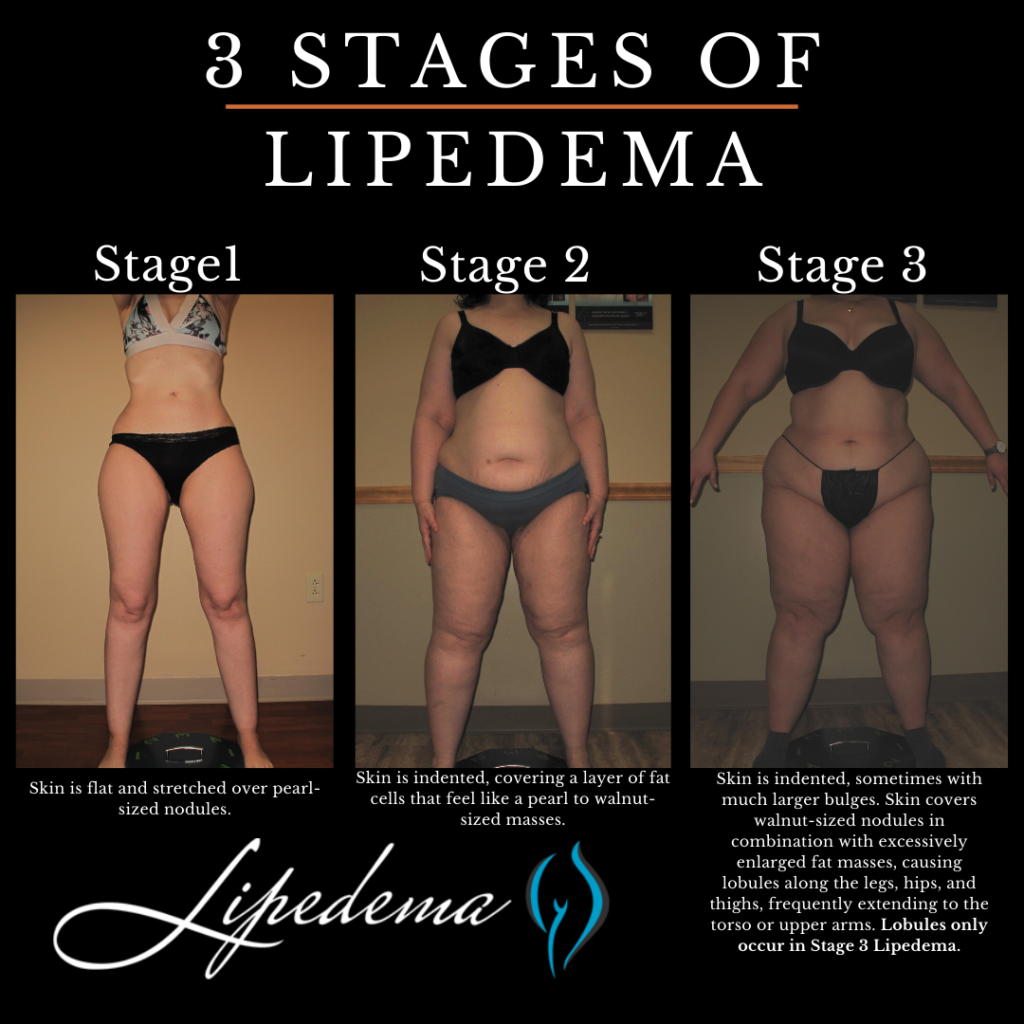

Lipedema is commonly described in three stages, although it is important to note that these stages of lipedema are not necessarily progressive. The stages reflect the severity of the condition and the presence of additional factors such as obesity and lymphedema.
At this stage, individuals primarily experience lipedema without significant obesity or lymphedema. The legs exhibit excess fat accumulation, and pressure on the fat deposits may cause pain. The skin remains healthy, and there is no visible swelling in the ankles or feet. While the symptoms may be bothersome, with proper management, Stage 1 lipedema can be effectively controlled.
In Stage 2 lipedema, the fat accumulation becomes more pronounced, and the pain and discomfort intensify. The affected areas may exhibit increased sensitivity, making daily activities challenging. At this stage, individuals may also begin to notice swelling in the ankles and feet, indicating the potential onset of lymphedema. It is crucial to seek appropriate treatment and lifestyle management strategies to prevent further progression.
Stage 3 lipedema represents the most severe form of the condition, often accompanied by significant obesity and lymphedema. The excess fat deposits are more extensive, causing considerable pain and impairing mobility. Swelling in the lower extremities becomes more apparent, requiring specialized treatment approaches to manage the combined effects of lipedema, obesity, and lymphedema.
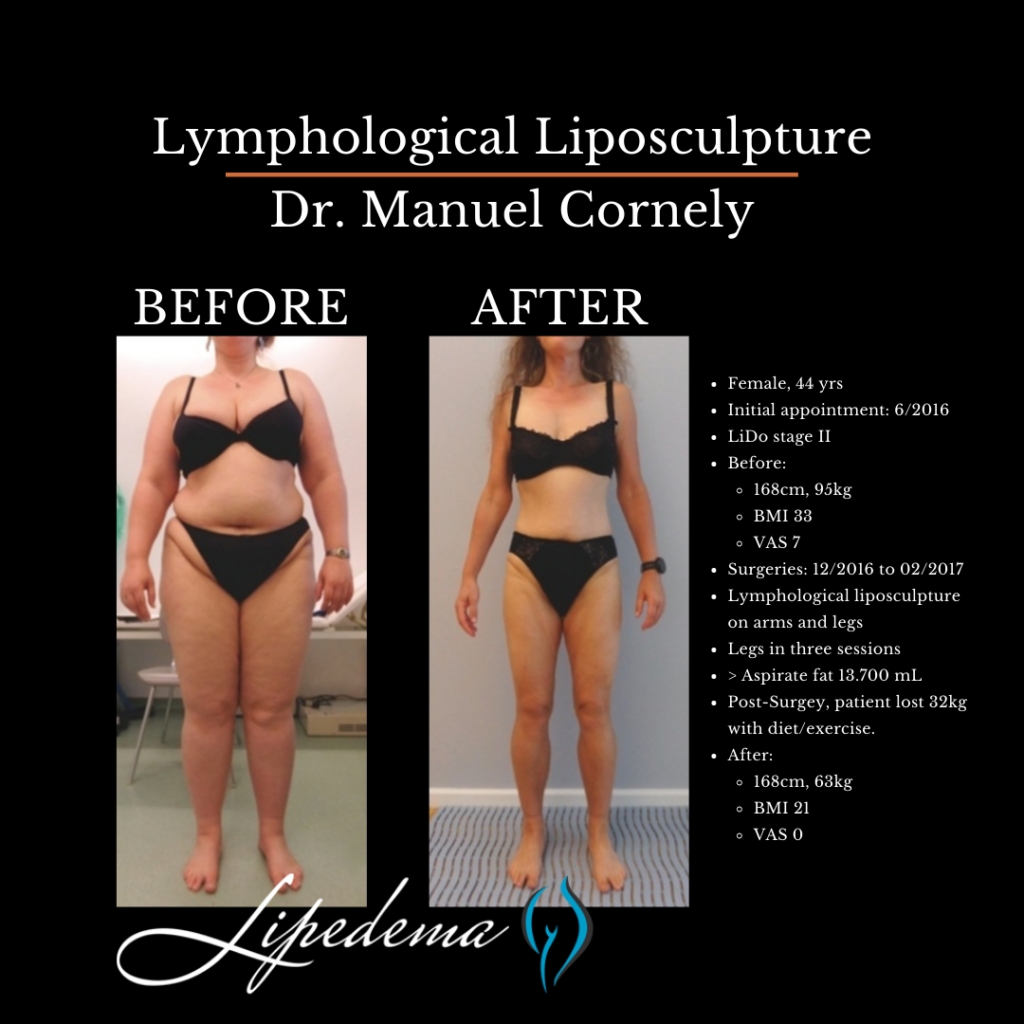

In St. Louis, there are various treatment options available for individuals living with lipedema. It is essential to consult with a healthcare professional experienced in managing this condition to develop a personalized treatment plan. A multidisciplinary approach is typically recommended, combining medical interventions, lifestyle modifications, and emotional support.
Medical interventions for lipedema focus on symptom management and improving overall well-being. The following treatments may be considered:


In addition to medical interventions, lifestyle modifications can greatly impact the management of lipedema. The following strategies may be beneficial:
Living with lipedema can be emotionally challenging, as individuals may face stigma, body image concerns, and difficulties in finding appropriate healthcare providers. Seeking emotional support and education can significantly improve coping mechanisms and overall mental health. Connecting with support groups, patient communities, and organizations dedicated to lipedema can provide valuable resources and a sense of belonging.
Lipedema is a chronic condition that requires a comprehensive approach to management. Understanding the causes, symptoms, and available treatment options is essential for individuals living with lipedema. In St. Louis, there are dedicated healthcare professionals experienced in diagnosing and treating lipedema. By implementing a combination of medical interventions, lifestyle modifications, and emotional support, individuals with lipedema can effectively manage their symptoms and improve their quality of life. Remember, early diagnosis and treatment are key to preventing further progression and maintaining optimal health. If you suspect you may have lipedema, consult with a healthcare professional experienced in managing this condition to develop a personalized treatment plan tailored to your specific needs.
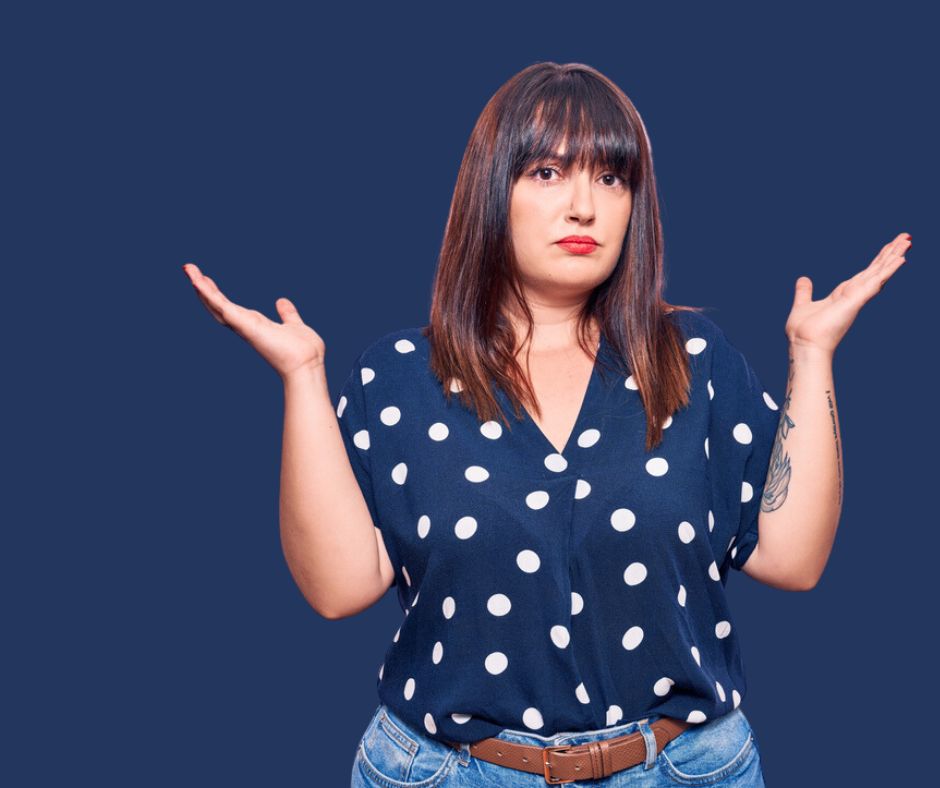

In today’s society, body image and weight management are often hot topics of discussion. Many individuals strive to achieve their desired physique through diet and exercise. However, for some, the struggle to lose weight in certain areas, particularly the legs, can be frustrating and confusing. This leads us to a common question: Is it lipedema or obesity? In this comprehensive guide, we will explore the key differences between lipedema and weight gain, helping you understand your body better and make informed decisions about your health and well-being.
Lipedema is a chronic and progressive medical condition characterized by the abnormal accumulation of fat cells, primarily in the lower body. It predominantly affects women, with an estimated prevalence of 7-11% in Western countries. Lipedema causes a disproportionate increase in fat deposits in the legs, hips, and buttocks while sparing the hands and feet. Individuals with lipedema often have a smaller waist and upper body, creating a distinct pear-shaped appearance.
One of the primary distinctions between lipedema and weight gain is that lipedema fat is resistant to traditional weight loss methods such as diet and exercise. Despite leading a healthy lifestyle, individuals with lipedema find it challenging to reduce fat in the affected areas. Lipedema fat can also exhibit unique characteristics, such as a gelatinous texture and the presence of small nodules beneath the skin.
Lipedema is thought to have a genetic component, with hormonal changes during puberty, pregnancy, and menopause potentially triggering its onset or exacerbation. It is crucial to understand that lipedema is not caused by obesity. While many individuals with lipedema may also be overweight or obese, the condition itself is independent of weight status.
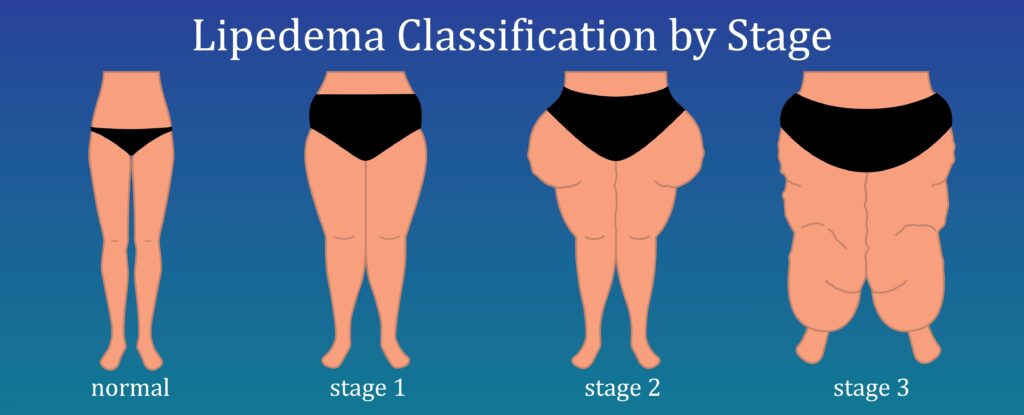

It is important to distinguish between lipedema and weight gain to ensure accurate diagnosis and appropriate treatment. While both conditions involve the accumulation of excess fat, they have distinct characteristics and underlying causes.
Lipedema presents with specific symptoms that differentiate it from general weight gain. Individuals with lipedema often experience:
In contrast, weight gain typically occurs more evenly throughout the body and is not associated with pain or other physical symptoms commonly seen in lipedema.
One of the key distinctions between lipedema and weight gain is the response to lifestyle changes. Individuals with lipedema often find that diet and exercise alone do not significantly impact the fat accumulation in the affected areas. Despite their best efforts, weight loss may be minimal or not occur at all in these specific regions. On the other hand, individuals experiencing general weight gain will typically see changes in their body composition through proper nutrition and physical activity.
Lipedema fat distribution differs from general weight gain. Lipedema fat primarily affects the lower body, including the legs, hips, and buttocks, while sparing the hands and feet. This leads to a distinct shape and disproportion between the upper and lower body. In contrast, weight gain is typically more evenly distributed throughout the body, without the characteristic pear-shaped appearance.
Lipedema not only affects physical health but can also have a significant psychological and emotional impact. Many individuals with lipedema experience depression, low self-esteem, and social isolation due to the perceived body image differences and the challenges associated with finding appropriately fitting clothing. Weight gain, on the other hand, may have similar psychological effects but is not specifically linked to the unique challenges faced by individuals with lipedema.
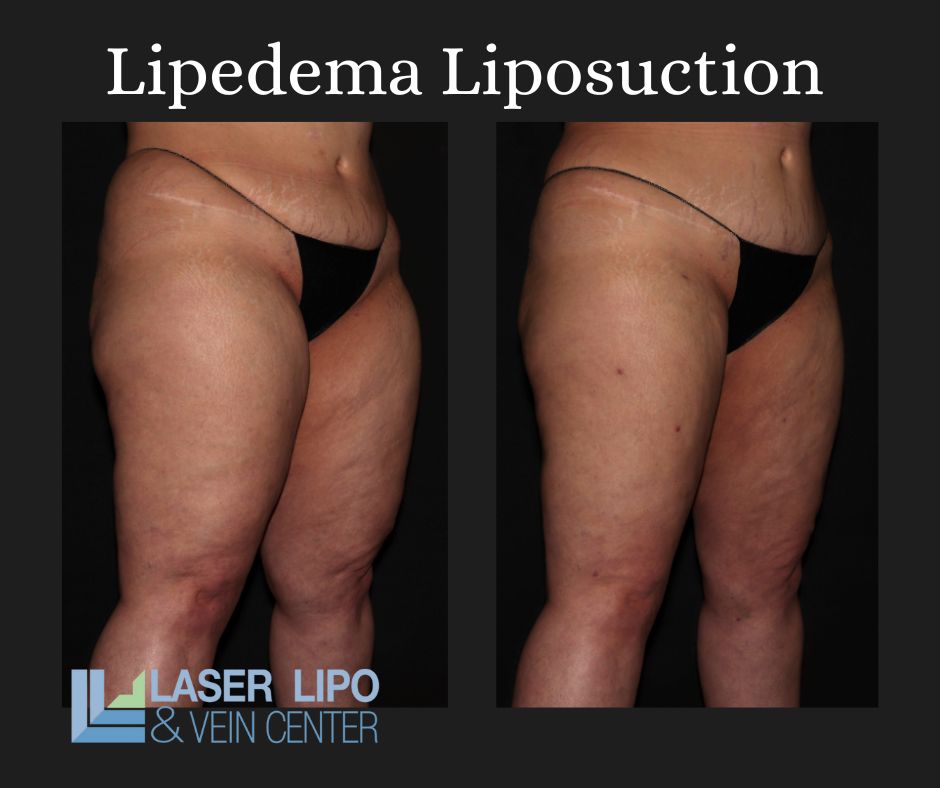

Accurate diagnosis is essential to establish appropriate treatment strategies for individuals with lipedema. If you suspect that you may have lipedema, it is crucial to consult with a healthcare professional experienced in the diagnosis and management of this condition. They will evaluate your symptoms, medical history, and perform a physical examination to assess fat distribution and other associated features.
Currently, there is no cure for lipedema, but various treatment options can help manage symptoms and improve quality of life. Treatment for lipedema may include:
It is important to note that liposuction is not a cure for lipedema but can offer significant improvements in symptoms and overall quality of life for select patients.


Understanding the difference between lipedema and weight gain is crucial for accurate diagnosis and appropriate treatment. Lipedema is a chronic condition characterized by the abnormal accumulation of fat in the lower body, while weight gain is a general increase in body weight. Lipedema fat is resistant to traditional weight loss methods, and individuals with lipedema often experience specific symptoms, such as pain, tenderness, and easy bruising.
If you suspect you may have lipedema, consulting with a healthcare professional or an experienced lipedema specialist is essential to develop an individualized treatment plan that addresses specific needs and goals. Dr. Wright and his team of experts are here for you whenever you’re ready to start your treatment journey!
Remember, your health and well-being are important, regardless of your body shape or size. By seeking appropriate care and support, you can live a fulfilling life and embrace your unique beauty.
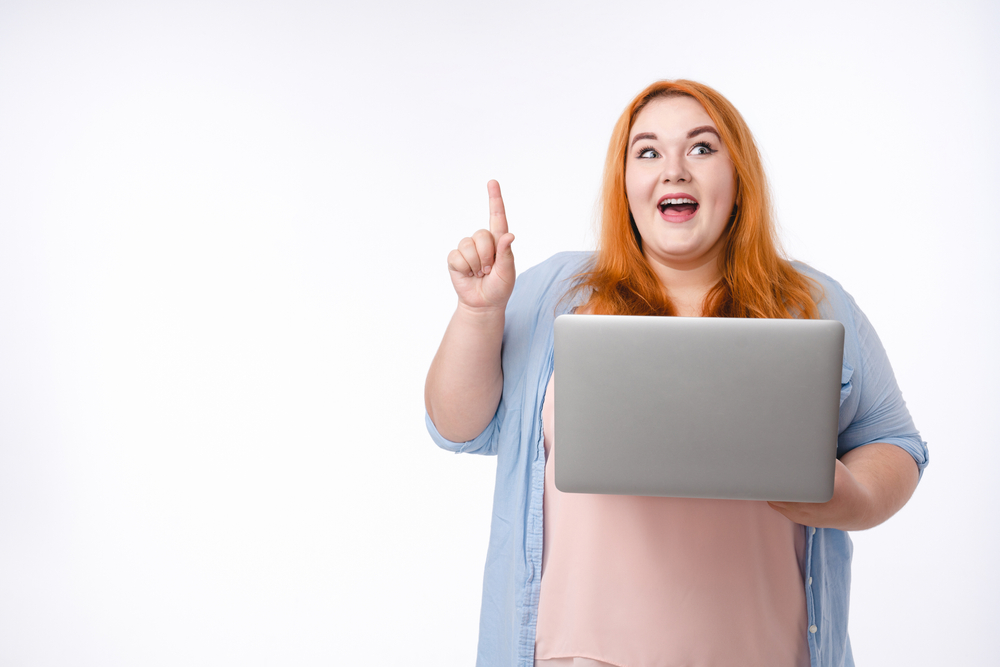

Lipedema is a condition that affects the distribution of fat in the body, primarily in the lower extremities. Lipedema is a progressive disorder and a significant portion of women with Lipedema progress to secondary Lymphedema. Understanding the relationship between lymphatics and Lipedema is crucial in understanding how lipedema develops and progresses.
It’s characterized as a “progressive disorder,” meaning the tissues enlarge and that, over time, there is a progressive deterioration of lymphatics. When looking at extracellular water content, which is a marker of lymphatic function, the higher the stage of lipedema, the greater the proportion of women with lipedema who also had increased amounts of extracellular water consistent with lymphatic impairment. To put it simply, research is finding that lipedema and lymphatic impairment are related.
The lymphatic system is responsible for maintaining the balance of fluids in the body and helps remove waste products and toxins through a network of vessels and lymph nodes. When the lymphatics are not functioning properly, fluid can build up, leading to swelling and inflammation. In the case of lipedema, there is often impaired lymphatic drainage. Excess fat cells can pressure the lymphatic vessels, causing them to become compressed and less effective at removing fluid.
Lymphatic impairment changes the whole biology of the affected tissues. In the legs and arms affected by lymphatic impairment, the biology of the fat cells and other connective tissues is changed. The cells and tissues are always creating proteins and storing and releasing fats as part of a normal, healthy bodily function. As part of this system, lymphatics are responsible for removing fatty acids, cellular debris, and large protein as they work to clean up, remodel, and maintain the structure and function of the tissues.
When we have lymphatic impairment in our tissues, the biology of these cells completely changes. There is an increased deposit of fibrous tissues, and the fat cells increase in number and size. These cells are no longer doing their job properly, and we don’t have equilibrium; the balance shifts towards tissue growth and fibrosis, leading to swelling and limb enlargement that is typical of lipedema and oftentimes, secondary lymphedema.
As the tissue enlarges in women with lipedema, we start to see more telltale signs of the disease, such as lobules and cuffs at the ankles and wrists. As these lobules and cuffs enlarge, the skin droops and hangs off the body. This, in turn, causes localized swelling and further disrupts the lymphatic flow, leading to a vicious cycle. The tissue enlargement caused by impaired lymphatics further disrupts lymphatic function. Read more about Lipedema Lobules and Nodules here.
Let’s break down in greater detail the lymphatic system and its role in maintaining healthy tissue. The lymphatic system is a network of vessels and organs that help remove waste, toxins, and excess fluid from our tissues. It plays a vital role in maintaining a healthy immune system and fluid balance. The lymphatics and veins are closely interconnected. Lymphatic vessels are responsible for carrying lymphatic fluid, which contains immune cells and waste products, while veins are responsible for carrying blood back to the heart. Both systems work together to ensure proper circulation throughout the body. For those struggling with vein health and lipedema, we’ve outlined the causes and treatments.
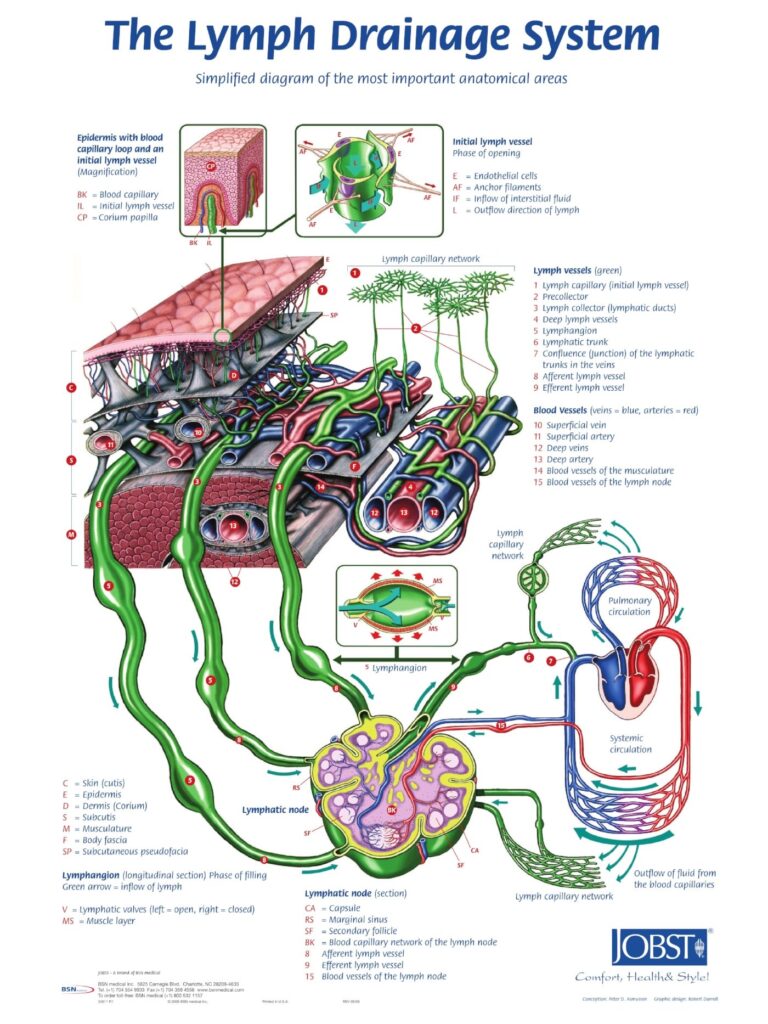

Like lipedema, lymphatic circulation has been neglected and largely ignored until recently. For example, the arterial-venous circulation system is nearly common knowledge. Most people learn about it in school, and we have a clear understanding of how it works: The heart pumps the blood through the arteries, which take the oxygenated blood to the tissues, and then the venous system returns the deoxygenated blood to the heart. This is a closed system. On the other hand, lymphatics are an open system that is seldom talked about in school. In this system, we aren’t focused on blood flow but on lymph fluid which is a clear and sometimes yellow-tinted proteinaceous fluid. Lymph is created in the tissues from the fluid that leaks out at the capillary level and contains large proteins, cells, and cellular debris.
The basic unit near the start of the lymphatic system is the lymphangion, which is a smooth muscle-lined vessel that propels the fluid toward our lymph nodes. The Lymphatic System is self-propelling. There are valves at the beginning of the lymphatic system that ensures that the fluid that enters will not be able to flow out and leave. Along the way, there are additional valves, much like the venous system, which ensure one-way flow. And also, like the venous system, the fluid is further aided and propelled forward by the contraction of muscles.
The lymphatics start at a lymphatic capillary level, which combines into lymphatic collecting ducts. These collecting ducts further collect together and become lymphatic trunks and enter lymph nodes. In the lymph nodes, the lymph is filtered, and lymphocytes scour and search for foreign cells and proteins that should be removed from the body. After the lymph is filtered through the lymph nodes, it’s sent toward the center of the body. Eventually, it ends up in the thoracic duct, where it returns to the venous circulation, just in front of the heart.
There are well-documented changes in the lymphatics of women with lipedema. Rasmusen and others have reported on dilated lymphatics in lipedema. Many other authors have reported on impairments of lymphatics in lipedema (Gould, Van De Pas). The following is a near-infrared direct lymphography image from research conducted by Dr. Wright. In it, you can see the difference between normal and Lipedema tissue found in the foot and ankle. In this image, there is normal, linear lymphatic flow in the lipedema patient’s foot, which changes to dilated, tortuous lymphatic flow as the lymph flows in the area of the ankle cuff caused by lipedema.
Normal lymphatic vessels seen with Near InfraRed [ NIR ] Imaging are linear and sharply demarcated, and as lymph moves into lipedema tissue, it becomes less demarcated and fuzzy or has more diffuse borders. Just towards the middle of the image at the foot/ankle border, you see right at the end, the sharp linear images become diffused and then no longer visible. This part is considered abnormal as it gets into the lipedema tissue.
The above images show that there are dilated lymphatics in lipedema and that there are reports that liposuction can injure lymphatics in lipedema. Now that we know the relationship between the two, it’s imperative that compression and other lymphatic flow-promoting treatments are included in the comprehensive treatment of lipedema. We’ll explain these practices below, and you can read more about the Lipedema Standard of Care here.
Before any type of surgery can be discussed, it’s important to ensure the non-surgical treatments are followed, and the lymphatic function is optimized. Examples of these practices are below, and you can also read an in-depth study about an approach to the best surgical outcomes by first addressing the inflammation in the tissues with dietary and lymphatic treatment. Read Dr. Amato’s research here.
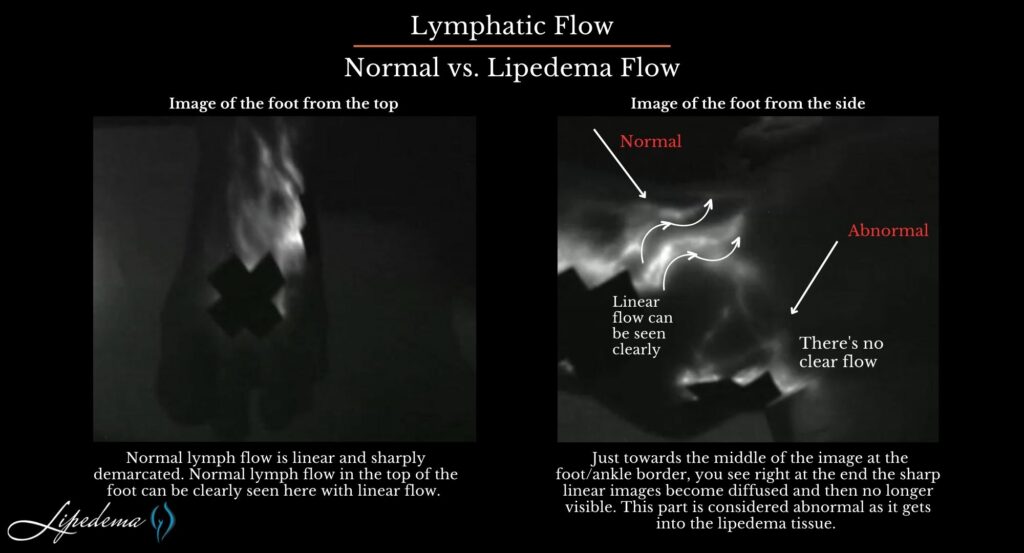

Compression garments, such as compression stockings or sleeves, can also be useful in providing external support to the lymphatic vessels and promoting fluid movement. In addition to these therapies, maintaining a healthy lifestyle is key. Regular exercise, a balanced diet, and weight management can help reduce the burden on the lymphatics and improve overall lymphatic function. In conclusion, lymphatics and lipedema are closely intertwined. The impaired lymphatic drainage seen in lipedema can contribute to chronic swelling and inflammation, further complicating the condition. Understanding this relationship is vital for effective treatment and management of lipedema, with therapies aimed at improving lymphatic function playing a significant role. Read more about compression therapy here.


Exercising can help to activate the lymphatic drainage system in a patient’s limbs through the foot and calf muscle pump. Workouts that aren’t too strenuous help to move the excess fluids out of affected limbs, as well as reduce additional fat buildup. Good lymph flow depends on proper joint and muscle activity. This is especially true if the lymphatic system is compromised. Individuals suffering from lipedema can receive a great benefit when engaging in diaphragmatic breathing exercises. These exercises are especially beneficial when they are combined together with other parts of a decongestive regimen.
Because fat disorders and lymphedema can often feed into one another, exercise is a great option to help combat both. With its dual purpose of clearing out excess lymph fluid and burning fat, exercise offers exactly what patients need to deal with these disorders. Learn more about the best types of exercise for lymphatic flow here.


Dr. Wright recommends following a Rare Adipose Disorder (RAD) diet, a modification to a standard Mediterranean diet that helps you maintain a low glycemic index to limit the number of occurrences and levels your blood sugar spikes through the day. To do this, it is recommended that you avoid any refined or processed starches and sugars. These are usually found in pasta, rice, bread, corn, and potatoes. Avoiding processed food – especially processed carbohydrates – will keep your insulin levels low and provide you the best chance of limiting inflammation. Read more about healthy eating and lymphatic flow here.


Manual lymph drainage is just one component of complete decongestive therapy (CDT). In addition to MLD, complete decongestive therapy includes compression, exercise, and skincare. These therapeutic components, when performed together, can ultimately relieve the symptoms of lipedema, which can often be painful.
When you stimulate the lymphatic system, you will feel the effects of several lymphatic drainage benefits:
Increase the capacity of the lymphatic system, which will then let it process more fluid than normal.:
Other lymphatic drainage massage benefits include reduction of pain and swelling and an increase of venous return and circulation. Learn more about this technique here.
In addition to several other procedures and treatments for lipedema, pump therapy, whole-body vibration, and dry brush massage can also increase the circulation of lymph fluids and relieve the sometimes painful symptoms. Learn more about whole-body vibration and dry brush massage below!
Because the lymphatic system lies just below the skin’s surface, dry brushing has been considered an effective treatment for lipedema. The benefits of dry brushing have been shown to provide :
The dry brushing technique is performed with a brush, either with a handle or a strap, that has soft bristles. As the name says, the brush is used dry and without water. You will not get the same results if the skin or brush is wet. With long, gentle, firm strokes, go over your entire body (except the face). The strokes should move the skin toward the heart and neck. Start with the feet and brush upward to the knees, groin, abdomen, and chest. Then brush the hands and arms to the armpits. Read more about dry brushing and lymphatic flow here.
Lipedema reduction surgery is a spin-off of liposuction focused on reducing lipedema tissues, including fibrous tissue, fat, and extracellular contents. It is possible for lymphatics to be injured by a suction cannula during lipedema reduction surgery and/or cosmetic liposuction. Some argue whether this is possible, but studies show it can, and unfortunately, may happen for some. In a recent study published in the American Journal of Case Reports, According to a study by Wright and Herbst confirms that this can occur. So, it is essential if you have lipedema or suspect you may have lipedema that you get a proper diagnosis and work closely with skilled surgeons well-versed in lipedema, lymphatics, and lymphedema for the best possible outcomes and treatment plan before you proceed with any type of liposuction.
During liposuction, some temporary interruption to the lymphatic vessels is unavoidable. In most patients, the lymphatics return to normal in the postoperative period, especially for patients with underlying normal lymphatic function [ Read patients without lymphedema or lipedema]. Suction lipectomy with small blunt cannulas and surgical techniques focusing on avoiding lymphatic damage has been reported to halt lipedema progression. [Sandofer 1, 2] A modification of suction lipectomy can result in alleviating or at least improving the swelling, leg heaviness, and fatigue, the need for limb compression, and the need for lymphatic massage in women with lipedema. In patients with impaired lymphatic function such as chronic lymphedema (or lipedema), careful suction lipectomy using techniques to avoid lymphatic injury can result in improved lymphatic function and a decreased rate of secondary infection or cellulitis in the affected limbs. [Gould. Van de Pas 3,4,]. Once you understand that lymphatics are impaired in lipedema and you understand that lymphatic injury can occur, the natural question arises – How can we protect the lymphatic system in lipedema surgery? Read more about surgical treatments for lipedema here, and contact Dr. Wright and his team at St. Louis Laser Lipo & Vein Center to see what kind of plan is best for you!